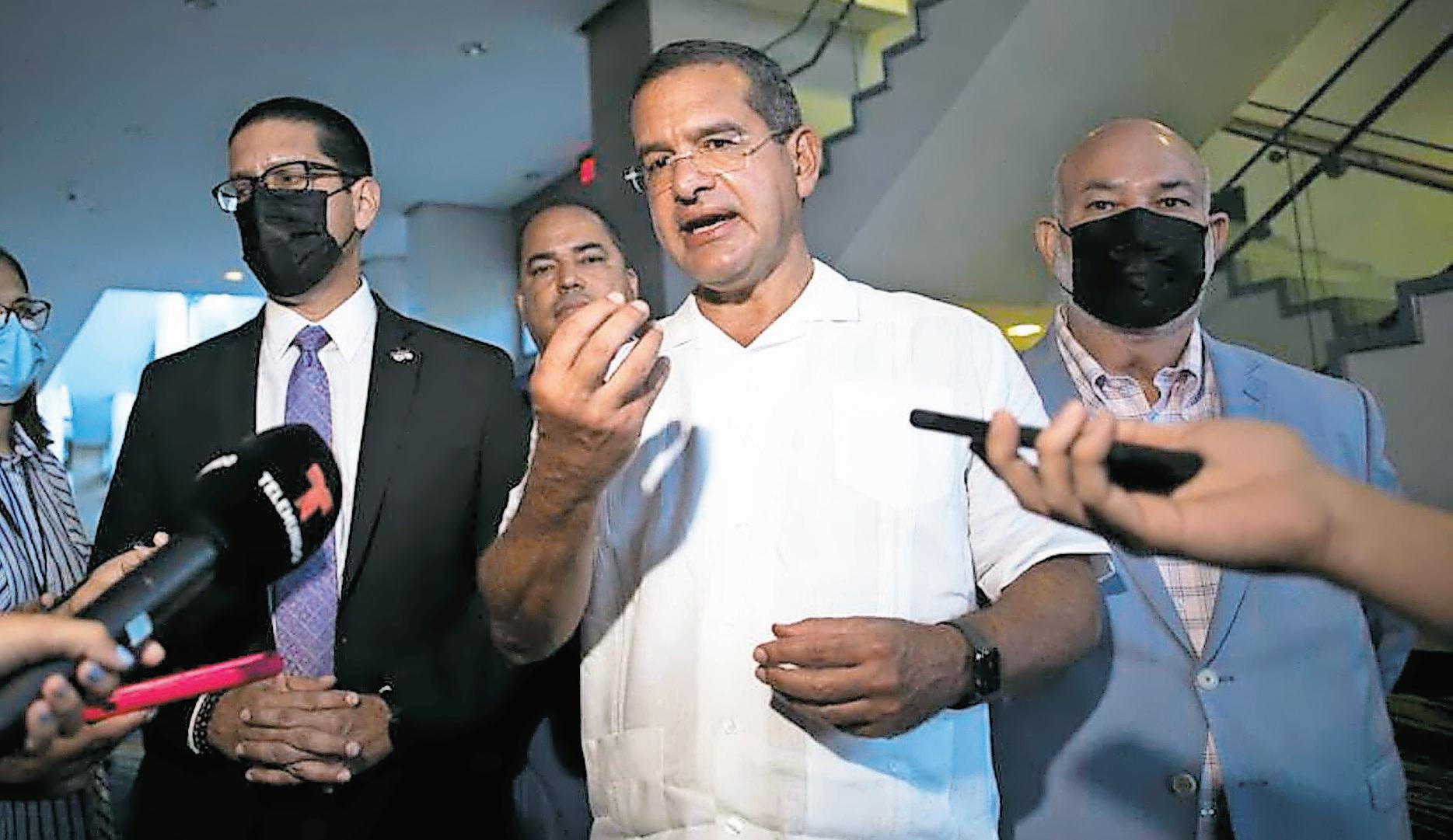
7 minute read
Latest on the PLan of adjustment
Passage of the Plan of Adjustment in Legislature Up in the Air
Amendments to guarantee pensions and the UPR do not convince all legislators
Advertisement
THE WEEKLY JOURNAL Staff
Despite the agreement reached over the weekend among the Financial Oversight and Management Board (FOMB), the two main parties in the Legislature and Gov. Pedro Pierluisi, the approval of the measure that creates the enabling law for the Plan of Adjustment (POA) remained uncertain as of press time Tuesday.
As reported, there was no assurance that House Bill 1003, known as the Law to End the Bankruptcy of Puerto Rico, would have the necessary votes for approval in both legislative bodies, since both majority and minority lawmakers publicly stated that they had objections with the new provisions included in the bill.
While both chambers were in session, another day of demonstrations had been called in front of the Capitol in repudiation of the POA and the measure that authorizes a new bond issue of $7.4 billion.
Recognizing the situation in the Legislature, Pierluisi said that he would ensure that the bill is approved. “I have been in communication with the legislative leadership to ensure that the legislation that makes the restructuring of the public debt feasible is approved, without affecting pensioners and protecting the University of Puerto Rico (UPR) and municipalities,” the governor said.
Pierluisi added that “it is crucial that this be achieved, since there is no doubt that the people would be seriously affected if the Plan of Adjustment submitted by the Board before the Federal Court falls and puts in danger for us (Puerto Rico) to get out of the bankruptcy.”
For his part, House Speaker Rafael “Tatito” Hernández presented the “substantive” changes that were made to the measure. Regarding pensions, he mentioned that a “super important” amendment was made, which “literally allows us to guarantee that the agreements are honored” and public pensions will not be cut.
Similarly, the measure includes language on UPR which states that the university’s budgets, which are submitted to the FOMB, include an allocation of $500 million for each of the five fiscal years from 2023 to 2027, providing that “additional allocations above the amounts allocated in the certified Fiscal Plan in April 2021 will be used to improve student experiences and the environment.”
Likewise, $1 million would be assigned to the Department of Health for “a study on the feasibility of providing or facilitating access to health insurance coverage to approximately 225,000 citizens who today lack coverage” and an extraordinary fund would be created based on a formula that, according to Hernández, would collect over $60 million annually to help municipalities with garbage collection and disposal, as well as recycling programs.
Gov. Pedro Pierluisi talks to the press after the much-awaited meeting at La Fortaleza on the Plan of Adjustment. >Josian E. Bruno Gómez
Red Flag Warnings
Regardless of the outcome of the voting on Tuesday, “red flag” warnings have been issued on the long-term success of Puerto Rico’s economic recovery and the island’s ability to pay its debt in the long run. “The Fiscal Plan certified by the FOMB for the central government sets in motion policies that have inconsistent effects on the real economy. First, the FOMB continues with the implementation of fiscal austerity measures, which it estimates will reduce GNP by 0.9 percent, 1.2 percent, and 0.7 percent during fiscal years 2022 (ongoing), 2023, and 2024, respectively. In their view, this fiscal consolidation is necessary to balance the budget in the short term. Note that the fiscal consolidation scheduled for FY2023 is particularly deep,” wrote Sergio Marxuach of the Center for a New Economy (CNE).
“On the other side of the equation, the FOMB is promoting the implementation of “structural reforms” in the areas of social welfare, energy, and ease of doing business, which it estimates will have a cumulative positive impact equal to 0.75 percent of GNP by fiscal year 2026. It is unclear, though, whether the government of Puerto Rico has the capability to implement these policies and, if implemented, whether they will have the economic impact forecasted by the FOMB,” he added.
As reported by THE WEEKLY JOURNAL, the FOMB has been touting the positive benefits of the POA. “The proposed Plan of Adjustment is a milestone on this path towards reducing Puerto Rico’s debt to sustainable levels and enabling economic growth,” said FOMB Executive Director Natalie Jaresko, adding that the plan comprises a series of agreements with a very diverse group of stakeholders, such as bondholders, unsecured creditors, retirees and unions.
Puerto Rico’s bankruptcy is not only the largest public debt restructuring in the history of the United States, but also extraordinarily complex, Jaresko noted. Puerto Rico’s $72 billion in debt was spread over more than a dozen public entities. The average debt service the government alone had to pay each year was $2.7 billion, and without PROMESA would have reached as much as $4.2 billion.
The Plan of Adjustment for the central government is the largest part of Puerto Rico’s debt restructuring, with about $35 billion in claims by bondholders and creditors, and more than $55 billion in pension liabilities.

>Archive
Foundation for Puerto Rico Announces New Program to Support Local Businesses
Focused on the visitor economy and supported by Wells Fargo
Zoe Landi Fontana, Collaborator
Foundation for Puerto Rico (FPR) announced the launch of their new program, [re]ACTIVA. This free technical training program was created to support small businesses within the visitor/tourism economy that have been disproportionately affected by the COVID-19 pandemic.
Supported by a $254,487 grant from the Wells
Fargo Open for Business Fund, a small business recovery effort that gives grants to nonprofits and
Community Development Financial Institutions (CDFIs), [re]ACTIVA will provide technical assistance and entrepreneurial education through coaching and workshops on high-demand business skills such as digital presence and e-commerce, both necessary for small businesses to succeed in the global market. FPR is the only local organization in Puerto Rico to receive such a grant from the Wells
Fargo Open for Business Fund. [re]ACTIVA’s support will be presented using three methods: individualized coaching, group training sessions, and on-demand workshops, of which the latter two will be available in a distance-learning format. Topics included are digital presence and e-commerce, marketing and promotion, brand image, forming a business plan, accounting and finance, Human Resources and operations, creation and retention of employees, and planning for the continuation of operations during emergencies. Investment in these areas are necessary for small businesses to adapt and grow while recognizing present and future challenges
Participants of [re]ACTIVA will work alongside expert mentors from prominent groups such as the Center for Entrepreneurs, JMC Ventures International, Awaken PR, Brands of Puerto Rico, and Gio Camacho Inc., whose areas of expertise range from business and real-estate investment to media and marketing strategy, among many others.
In order to be eligible, the business must be located in Puerto Rico and targeted on the visitor economy, have three to 10 employees, annual sales of less than $1 million, and documented proof of sales or clients lost as a result of the COVID-19 pandemic. The program is projected to reach 200 small and medium-sized enterprises islandwide, providing 400 hours of workshops, 400 hours of 1-on-1 coaching, with a goal to preserve 120 businesses and create 500 employees. In 2017, in the aftermath of Hurricane Maria, FPR established the Small Business Support Program to provide aid to existing local small businesses, which employ over 80 percent of all private sector employees in Puerto Rico. According to the Federal Emergency Management Agency (FEMA),
In fact, after a disaster, 40 percent to 60 percent of small businesses do not reopen, and an additional 25 According percent will close one year later. to FEMA, after a The COVID-19 pandemic further disaster, 40 percent impeded the recovery of small to 60 percent of businesses on the island, the small businesses do FPR noted, while simultaneously not reopen, and an calling for diversification and additional 25 percent innovation to remain competitive will close one year in the post-pandemic world. later. Anneliz Oliver, Economic Development Programs manager at FPR expressed the new program’s mission as seeking “[to] promote the economic recovery of small businesses affected by COVID-19, providing small business owners with technical assistance on topics such as access to capital, finance, marketing, business planning and electronic commerce, among others. With expert-led technical training and additional recovery resources, FPR aims to help these businesses stay open, retain employees, and optimize their operations and offerings” Applications should be submitted on FPR’s [re] ACTIVA webpage by Friday, Nov. 26, 2021.




